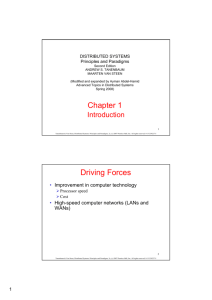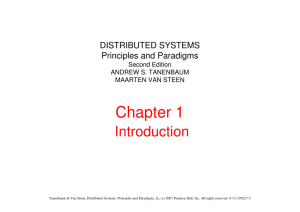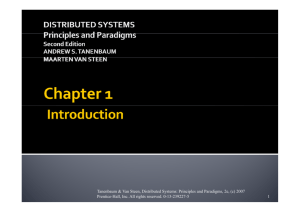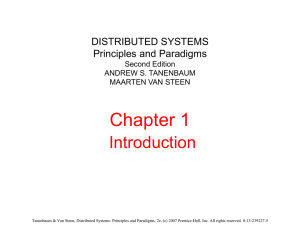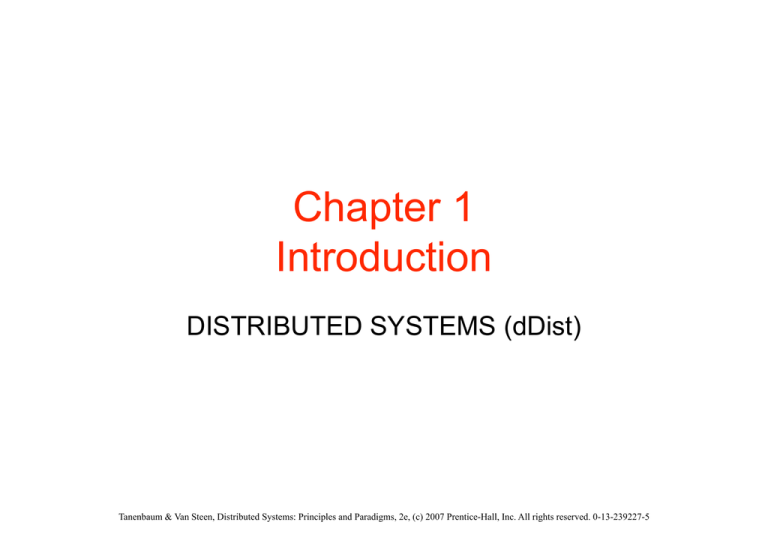
Chapter 1
Introduction
DISTRIBUTED SYSTEMS (dDist)
Tanenbaum & Van Steen, Distributed Systems: Principles and Paradigms, 2e, (c) 2007 Prentice-Hall, Inc. All rights reserved. 0-13-239227-5
Plan
• Definition
• Characteristics of distributed systems
• Main types of distributed systems
Tanenbaum & Van Steen, Distributed Systems: Principles and Paradigms, 2e, (c) 2007 Prentice-Hall, Inc. All rights reserved. 0-13-239227-5
Definition of a Distributed System (1)
• A distributed system is:
– A collection of independent computers that
appears to its users as a single coherent
system.
Tanenbaum & Van Steen, Distributed Systems: Principles and Paradigms, 2e, (c) 2007 Prentice-Hall, Inc. All rights reserved. 0-13-239227-5
An Example
• Electronic Healthcare Record
– Medication, planning, integration
– Critical system
– A large, distributed system
• System architecture
–
–
–
–
–
Clients
Servers
Legacy systems
Peripherals
…
A distributed system is a collection of independent
computers that appears to its users as a single
coherent system.
Tanenbaum & Van Steen, Distributed Systems: Principles and Paradigms, 2e, (c) 2007 Prentice-Hall, Inc. All rights reserved. 0-13-239227-5
Definition of a Distributed System (2)
A distributed system is a collection of independent
computers that appears to its users as a single coherent
system.
• Other examples of distributed systems?
Tanenbaum & Van Steen, Distributed Systems: Principles and Paradigms, 2e, (c) 2007 Prentice-Hall, Inc. All rights reserved. 0-13-239227-5
Definition of a Distributed System (3)
Figure 1-1. A distributed system organized as middleware. The
middleware layer extends over multiple machines, and offers
each application the same interface.
Tanenbaum & Van Steen, Distributed Systems: Principles and Paradigms, 2e, (c) 2007 Prentice-Hall, Inc. All rights reserved. 0-13-239227-5
Definition of a Distributed System (4)
• Leslie Lamport
– “A distributed system is a system where I
can’t get my work done because a computer
has failed that I’ve never even heard of.”
• Why are such failures central and specific
to distributed systems?
• Can we not just build better systems?
Tanenbaum & Van Steen, Distributed Systems: Principles and Paradigms, 2e, (c) 2007 Prentice-Hall, Inc. All rights reserved. 0-13-239227-5
Motivation and Goals
• Making resources available
– Systems should allow for efficient and controlled
access to and sharing of distributed/remote resources
• Hiding distribution
– Systems should look as if only a single computer
system is running
• Openness
– Systems should offer services according to standard
rules that describe the syntax and semantics of those
services
• Scalability
– Systems should scale with respect to size,
geography, and administrative boundaries
Tanenbaum & Van Steen, Distributed Systems: Principles and Paradigms, 2e, (c) 2007 Prentice-Hall, Inc. All rights reserved. 0-13-239227-5
Transparency in a Distributed System
Figure 1-2. Different forms of transparency in a
distributed system (ISO, 1995).
Tanenbaum & Van Steen, Distributed Systems: Principles and Paradigms, 2e, (c) 2007 Prentice-Hall, Inc. All rights reserved. 0-13-239227-5
Scalability?
Figure 1-3. Examples of scalability limitations.
Tanenbaum & Van Steen, Distributed Systems: Principles and Paradigms, 2e, (c) 2007 Prentice-Hall, Inc. All rights reserved. 0-13-239227-5
Scalability Problems
• Using decentralized algorithms:
– No machine has complete information about
the system state.
– Machines make decisions based only on local
information.
– Failure of one machine does not ruin the
algorithm.
– There is no implicit assumption that a global
clock exists.
• Why the last requirement?
Tanenbaum & Van Steen, Distributed Systems: Principles and Paradigms, 2e, (c) 2007 Prentice-Hall, Inc. All rights reserved. 0-13-239227-5
Scaling Techniques (1)
•
Synchronous communication
– Ttotal > T1 + T2
•
Asynchronous communication
– Possible that Ttotal <= T1 + T2
Tanenbaum & Van Steen, Distributed Systems: Principles and Paradigms, 2e, (c) 2007 Prentice-Hall, Inc. All rights reserved. 0-13-239227-5
Scaling Techniques (2)
Figure 1-4. The difference between letting (a) a server
or (b) a client check forms as they are being filled.
Tanenbaum & Van Steen, Distributed Systems: Principles and Paradigms, 2e, (c) 2007 Prentice-Hall, Inc. All rights reserved. 0-13-239227-5
Scaling Techniques (3)
Figure 1-5. An example of dividing the DNS
name space into zones.
• Can distribution and replication give problems?
Tanenbaum & Van Steen, Distributed Systems: Principles and Paradigms, 2e, (c) 2007 Prentice-Hall, Inc. All rights reserved. 0-13-239227-5
Pitfalls when Developing
Distributed Systems
• Transparency cannot be a reality
• False assumptions made by first time developer:
– The network is reliable.
– The network is secure.
– The network is homogeneous.
– The topology does not change.
– Latency is zero.
– Bandwidth is infinite.
– Transport cost is zero.
– There is one administrator.
Tanenbaum & Van Steen, Distributed Systems: Principles and Paradigms, 2e, (c) 2007 Prentice-Hall, Inc. All rights reserved. 0-13-239227-5
Main Distributed System Types
• Distributed computing systems
– Focus on computation
• Distributed information systems
– Focus on interoperability
• Distributed pervasive systems
– Focus on mobile, embedded, communicating
systems
Tanenbaum & Van Steen, Distributed Systems: Principles and Paradigms, 2e, (c) 2007 Prentice-Hall, Inc. All rights reserved. 0-13-239227-5
Cluster Computing Systems
Figure 1-6. An example of a cluster computing system.
Tanenbaum & Van Steen, Distributed Systems: Principles and Paradigms, 2e, (c) 2007 Prentice-Hall, Inc. All rights reserved. 0-13-239227-5
NFIT Spam Cluster
• University of Aarhus cluster
– 2 * 2 redundant front-ends (64-bit Opteron servers) at two sites
– 2 redundant back-ends at each site (64-bit Opteron servers)
– It is possible to add new back-ends
• Use
– Spam filtering for postAU, NF, SAMF, HUM, ADM, HIH
– 25k-40k
users
– Now around
500k spams
a day
Tanenbaum & Van Steen, Distributed Systems: Principles and Paradigms, 2e, (c) 2007 Prentice-Hall, Inc. All rights reserved. 0-13-239227-5
Grid Computing Systems
• Figure 1-7. A layered architecture for grid
computing systems.
Tanenbaum & Van Steen, Distributed Systems: Principles and Paradigms, 2e, (c) 2007 Prentice-Hall, Inc. All rights reserved. 0-13-239227-5
NorduGrid
•
Grid research and development
collaboration
– Denmark, Finland, Sweden,
Norway
– Supporting researchers
– Originally in particular for Large
Hadron Collider experiments
•
Advanced Resource Connector
(ARC) middleware
Tanenbaum & Van Steen, Distributed Systems: Principles and Paradigms, 2e, (c) 2007 Prentice-Hall, Inc. All rights reserved. 0-13-239227-5
Transaction Processing Systems
• Figure 1-8. Example primitives for transactions.
Tanenbaum & Van Steen, Distributed Systems: Principles and Paradigms, 2e, (c) 2007 Prentice-Hall, Inc. All rights reserved. 0-13-239227-5
Example
BEGIN_TRANSACTION
salary1 = doctor1.getSalary()
doctor1.setSalary(salary1 + bonus)
salary2 = doctor2.getSalary()
doctor2.setSalary(salary2 - bonus)
END_TRANSACTION
Tanenbaum & Van Steen, Distributed Systems: Principles and Paradigms, 2e, (c) 2007 Prentice-Hall, Inc. All rights reserved. 0-13-239227-5
Characteristic properties of
transactions
• Atomic
– To the outside world, the transaction happens
indivisibly.
• Consistent
– The transaction does not violate system invariants.
• Isolated
– Concurrent transactions do not interfere with each
other.
• Durable
– Once a transaction commits, the changes are
permanent.
Tanenbaum & Van Steen, Distributed Systems: Principles and Paradigms, 2e, (c) 2007 Prentice-Hall, Inc. All rights reserved. 0-13-239227-5
Isolation/Serializability
• T1 and T2 executed concurrently/interleaved,
effects will be as
– T1 executed, then T2 executed, or
– T2 executed, then T1 executed
• Simple, but slow approach:
– Run transactions serially, i.e., no interleaving...
• The point here is that database server may
optimize based on interleaved scheduling of
transcation steps!
Tanenbaum & Van Steen, Distributed Systems: Principles and Paradigms, 2e, (c) 2007 Prentice-Hall, Inc. All rights reserved. 0-13-239227-5
Lost Update
•
T1
•
T2
– salary1 = doctor1.getSalary()
– salary1 = doctor1.getSalary()
– doctor1.setSalary(salary1 +
bonus)
– doctor1.setSalary(salary1 +
bonus)
– salary2 = doctor2.getSalary()
– doctor2.setSalary(salary2 - bonus)
– salary3 = doctor3.getSalary()
– doctor3.setSalary(salary3 - bonus)
Tanenbaum & Van Steen, Distributed Systems: Principles and Paradigms, 2e, (c) 2007 Prentice-Hall, Inc. All rights reserved. 0-13-239227-5
A Serializable Transaction
Interleaving
•
T1
– salary1 = doctor1.getSalary()
– doctor1.setSalary(salary1 +
bonus)
– salary2 = doctor2.getSalary()
– doctor2.setSalary(salary2 - bonus)
•
T2
– salary1 = doctor1.getSalary()
– doctor1.setSalary(salary1 +
bonus)
– salary3 = doctor3.getSalary()
– doctor3.setSalary(salary3 - bonus)
Tanenbaum & Van Steen, Distributed Systems: Principles and Paradigms, 2e, (c) 2007 Prentice-Hall, Inc. All rights reserved. 0-13-239227-5
Inconsistent Retrievals
• T1
• T2
– ward1.discharge(patient)
– sum += ward1.getNoPatients()
– sum += ward2.getNoPatients()
– ward2.admit(patient)
Tanenbaum & Van Steen, Distributed Systems: Principles and Paradigms, 2e, (c) 2007 Prentice-Hall, Inc. All rights reserved. 0-13-239227-5
Transaction Processing Systems (3)
• Figure 1-9. A nested transaction.
Tanenbaum & Van Steen, Distributed Systems: Principles and Paradigms, 2e, (c) 2007 Prentice-Hall, Inc. All rights reserved. 0-13-239227-5
Transaction Processing Systems (4)
• Figure 1-10. The role of a TP monitor in
distributed systems.
Tanenbaum & Van Steen, Distributed Systems: Principles and Paradigms, 2e, (c) 2007 Prentice-Hall, Inc. All rights reserved. 0-13-239227-5
Enterprise Application Integration
• Figure 1-11. Middleware as a communication facilitator
in enterprise application integration.
Tanenbaum & Van Steen, Distributed Systems: Principles and Paradigms, 2e, (c) 2007 Prentice-Hall, Inc. All rights reserved. 0-13-239227-5
Distributed Pervasive Systems
!
!
!
Tanenbaum & Van Steen, Distributed Systems: Principles and Paradigms, 2e, (c) 2007 Prentice-Hall, Inc. All rights reserved. 0-13-239227-5
Distributed Pervasive Systems
• Requirements for pervasive systems
– Embrace contextual changes.
– Encourage ad hoc composition.
– Recognize sharing as the default.
Tanenbaum & Van Steen, Distributed Systems: Principles and Paradigms, 2e, (c) 2007 Prentice-Hall, Inc. All rights reserved. 0-13-239227-5
Electronic Health Care Systems
• Figure 1-12. Monitoring a person in a pervasive electronic
health care system, using
– (a) a local hub or
– (b) a continuous wireless connection.
Tanenbaum & Van Steen, Distributed Systems: Principles and Paradigms, 2e, (c) 2007 Prentice-Hall, Inc. All rights reserved. 0-13-239227-5
Network Centric Warfare
Tanenbaum & Van Steen, Distributed Systems: Principles and Paradigms, 2e, (c) 2007 Prentice-Hall, Inc. All rights reserved. 0-13-239227-5
Sensor Networks (1)
• Questions concerning sensor networks:
– How do we (dynamically) set up an efficient
tree in a sensor network?
– How does aggregation of results take place?
Can it be controlled?
– What happens when network links fail?
Tanenbaum & Van Steen, Distributed Systems: Principles and Paradigms, 2e, (c) 2007 Prentice-Hall, Inc. All rights reserved. 0-13-239227-5
Sensor Networks (2)
• Figure 1-13. Organizing a sensor network database, while
storing and processing data (a) only at the operator’s site or …
Tanenbaum & Van Steen, Distributed Systems: Principles and Paradigms, 2e, (c) 2007 Prentice-Hall, Inc. All rights reserved. 0-13-239227-5
Sensor Networks (3)
• Figure 1-13. Organizing a sensor network database, while
storing and processing data … or (b) only at the sensors.
Tanenbaum & Van Steen, Distributed Systems: Principles and Paradigms, 2e, (c) 2007 Prentice-Hall, Inc. All rights reserved. 0-13-239227-5
Summary
A distributed system is a collection of independent
computers that appears to its users as a single
coherent system.
• Goals and problems include
–
–
–
–
Access to resources
Transparency
Openness
Scalability
• Types of systems
– Distributed Computing Systems
– Distributed Information Systems
– Distributed Pervasive Systems
Tanenbaum & Van Steen, Distributed Systems: Principles and Paradigms, 2e, (c) 2007 Prentice-Hall, Inc. All rights reserved. 0-13-239227-5

